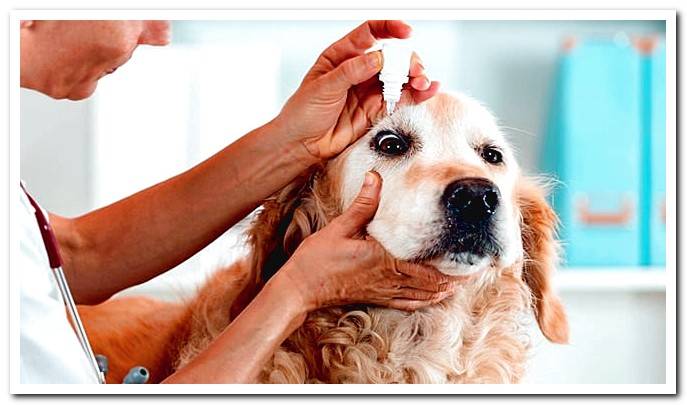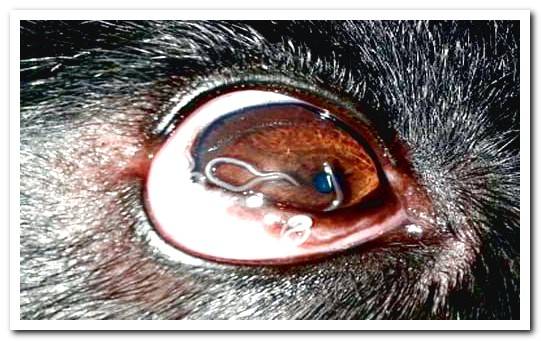
Thelazia is an increasingly common eye parasite in dogs, although it is a great unknown for people who live with them. And it is that although it is originally from Asia, it is expanding and has already settled in countries such as Spain or Mexico.
Knowing what its life cycle is and how it is transmitted is essential in order to take the necessary precautions and avoid contagion, since thelaziosis is not only a disease that affects dogs, also cats, horses and even being human.
From Dogsis we will detail what are the symptoms of thelazia, what treatment options are there and finally, we will give you some tips to prevent it.
Index of contents
- 1 What is thelazia and what is its biological cycle?
- 2 What are the symptoms of canine thelazia?
- 3 Treatment for thelazia
- 4 How to prevent canine thelazia
What is thelazia and what is its biological cycle?
Thelazia it is a roundworm that lodges inside the dog’s eye. The most common variant of this parasite is usually the thelazia callipaeda, which is transmitted through fruit flies.
The warmest months, from May to November, are those that present the greatest risk since it is when these flies proliferate and look for the ocular secretions of the dogs to feed. If they are carriers of the parasite, it is at that moment when the contagion occurs.
Within the biological cycle of thelazia, the dog is the definitive host and the intermediary is the fruit fly. When it ingests infected secretions, the larvae mature and in about three weeks they move to the fly’s mouth.
In this way, when it comes to feed on the ocular secretions of another healthy dog, it will transmit the parasite. And this is how the biological cycle of thelazia restarts over and over again.

What are the symptoms of canine thelazia?
Thelazia can be diagnosed with the naked eye by seeing the parasite in the dog’s eye. The worms are thread-like and whitish in color. They can measure between 7 and 17 millimeters in length, with a diameter of between 0.3 and 0.8 millimeters.
If it is not possible to see them directly, because they are hidden under the membrane of the third eyelid, there are a series of symptoms that can make us suspect that the dog has thelaziosis. The most common are:
- Conjunctivitis
- Excessive tearing and discharge from the eyes
- Involuntary contraction of the eyelids
- Intense itching, which can cause hair loss around the eyes from scratching or injuries such as a corneal ulcer.
If the dog shows these signs and usually lives outside, near fruit trees, it is advisable to visit the vet so that he can examine it and make a diagnosis. These symptoms can appear only in one or both eyes, between 7 and 15 days after the arrival of the parasite.
Treatment for thelazia
Thelazia treatment will vary if the worms can be located or not with the naked eye. In the event that they can be seen, it will be normal for the vet to extract them manually.
If this is not possible, then you will have to try products like milbemycin, used for internal deworming. And in the event that there are ulcers or other injuries, these should receive specific treatment.
It is very important that let’s never act on our own and that we follow the instructions given by a veterinaryn so as not to endanger the dog, and administer the correct dose and type of treatment.

How to prevent canine thelazia
To avoid having to get to this point, the best remedy is good prevention. It is true that it is not easy to avoid the presence of these flies in the hot months, but following a series of recommendations the chances of the dog becoming infected with this parasite can be reduced. Some of the tips to keep in mind are:
- Try that during the months in which there are fruit flies the dogs stay more indoors, so that they do not come into contact with them.
- Try to avoid walking around areas where you perceive the presence of this type of flies.
- Try not to have any fallen fruit from the trees, leaves or other organic matter nearby, so that the flies do not proliferate.
- Use repellents and mosquito nets for better environmental control.
Something highly recommended are sunglasses for dogs, as this hinders the access of flies to the eyes.
In addition, during the most troublesome months we should check the dog’s eyes more frequently and carry out more routine checks at the vet so that thelazia, if they appear, does not take us by surprise.
So it can be treated as soon as possible to avoid major complications in our furry friend. Above all, if it is not the first time it has happened
